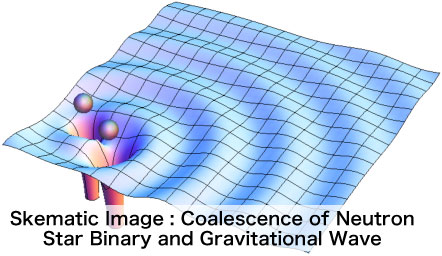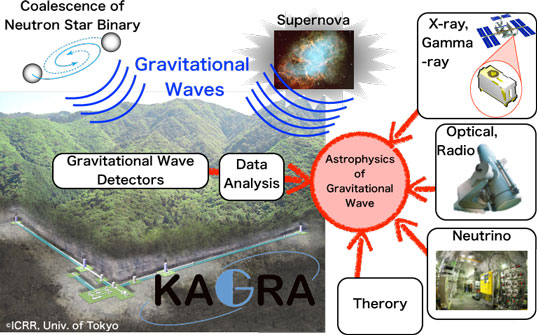About GWAstro
About
New Developments in Astrophysics Through Multi-Messenger Observations of Gravitational Wave Sources
Takashi Nakamura (Kyoto University, Graduate School of Science, Professor)
Purpose of the Research Project
One hundred years ago, Albert Einstein’s the-ory of general relativity predicted the existence of gravitational waves (GW). However, their effects are expected to be extremely subtle, and as a result they have not yet been detected. Now, a new generation of GW detectors are coming online in the US, Europe, and Japan. They should be ready to detect strong sources of gravitational waves - like the collapse of a heavy star into a supernova and black hole, or the coalescence of a neutron star binary - as early as 2016. Such powerful GW sources should also emit a wide variety of other “mes-sengers”: X-rays, gamma-rays, visible and in-frared light, radio waves, and neutrinos. The goal of this new innovative area is to enable both coincident and follow-up observations of these messengers through collaborative efforts in Japan, and by doing so to thereby extend man’s understanding of the universe via: (1) confirmation of Einstein’s 100-year-old predic-tion, and (2) observationally establishing the origin of the substances which comprise both humans and the world around them.

Content of the Research Project
To conclusively demonstrate the observation of gravitational waves, we need not only detection of the gravitational waves themselves but also counterpart observations. Our innovative re-search area consists of three categories of ob-servations as well as two types of gravitational wave study: X-ray/gamma-ray (A01), opti-cal/radio (A02), neutrino (A03), gravitational wave data analysis (A04), and theoretical GW research (A05). We wish to probe the inside of gravitational wave sources with the cooperation of these research projects.

Expected Research Achievements and Scientific Significance
Once gravitational waves are observed, signals from other messengers are expected. In the case of the coalescence of a neutron star binary, gravitational wave data analysis will roughly suggest the arrival direction. A rapid follow-up of X-ray and/or gamma-ray observations will narrow down the arrival direction, while optical follow-ups should allow identification of the host galaxy. In case of a supernova in our own galaxy, coincident detection of neutrinos would give certain confirmation of a gravitational wave signal. These simultaneous measure-ments - the only known techniques to look into the very heart of a collapsing star - will provide vital knowledge of these astronomical objects.
Key Words
General Relativity: General theory of gravity (which includes Newton’s gravity), proposed by A. Einstein at 1915. Based on this theory, there are many ideas regarding what happens in strong gravity fields, but experimental data is lacking. Gaining observational GW data will likely provide the key to creating a modern, 21st century unified theory which includes gravity.
Gravitational Wave : Wave in the gravity field which was predicted by Einstein according to general relativity. Gravitational waves should propagate at the speed of light and distort space-time, but the direct measurement of this propagation has not yet been established.
Term of Project
FY2012-FY2016
Budget Allocation
798,500,000 Yen